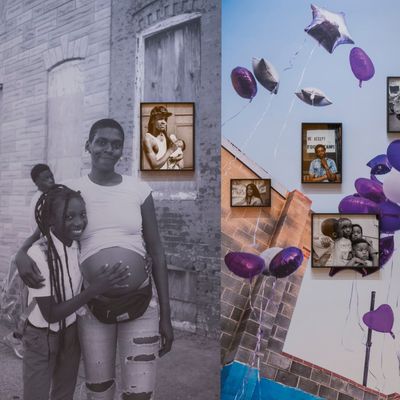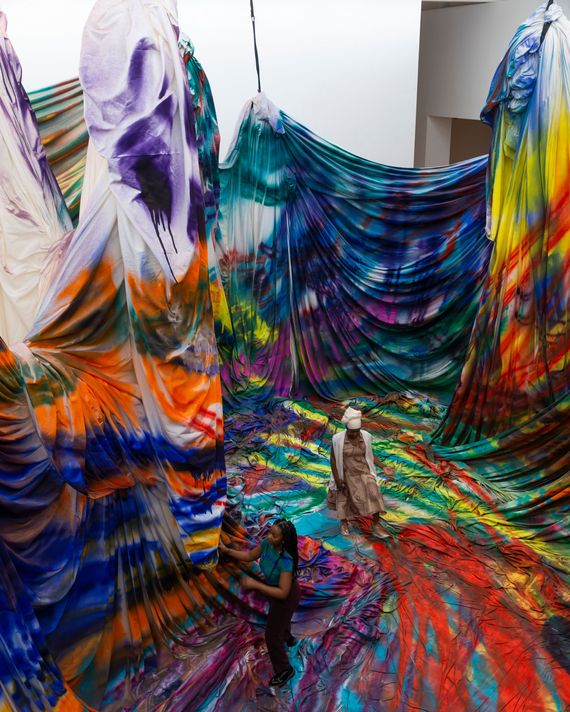
Male artists have long had their time in the sun. Now, in order to address common race and gender diversity gaps within the museum field, the Baltimore Museum of Art has launched a radical new program, the 2020 Vision Initiative, a year of exhibitions and programming dedicated to the artistic achievements of female-identifying creatives. Between fall 2019 and fall 2020 (timed to the coincide with the centennial celebration of the 19th Amendment), 23 exhibitions will highlight female artists, many of them women of color with ties to the city of Baltimore. Read on to meet some of the solo artists and see their work.
Howardina Pindell
The museum features Pindell’s 1980 video Free, White and 21. The video is her own account of growing up as a black woman in America, offering unique perspectives on gender and race.
“My grandmother lived in Baltimore, a row house in a very nice neighborhood, and I visited her there often. We stayed in the neighborhood. It was during Jim Crow and I don’t think I ever saw a white person. I never even thought about it. I didn’t even know that the museum existed, and it’s exciting to think of myself then and myself now, in the museum. I see that little girl.” —Pindell
Jo Smail
During her career, Smail has overcome a studio fire that destroyed all of her work and a stroke that left her unable to move or speak. Her new exhibit, Flying With Remnant Wings, features her paintings and works on paper, as well as collages that she collaborated on with fellow South African artist William Kentridge.
“I grew up under a hideous regime called apartheid. I felt I had to acknowledge this. A world of extremes. I use in my work the joy I felt in the African fabrics I have collected for years as a counterpoint against the extreme cruelty reflected in printed texts of the political environment in which I lived. These are the stories behind my work.” —Smail
Katharina Grosse
Grosse’s colorful, large-scale paintings challenge notions of where painted images can exist. Instead of using a canvas or a more traditional medium, Grosse often paints directly onto architectural structures, objects, and even landscapes, as shown in her exhibit Is It You?
“Painting isn’t connected to certain surfaces or materials or to a particular place. A painting can land and remain anywhere: on a rubber boot, on an egg, in the crook of the arm, in the garden, on the bulging folds of a fabric, along a train platform, in the snow and ice, or on the beach. If painting isn’t connected to a place, then the imagination is not connected to a place; and since imagination is immediate reality, reality as well is site-less. I want to show that it is always possible — not only for me, but for everyone — to also view and experience reality differently.” —Grosse
SHAN Wallace
Wallace’s exhibit, 410, is a series of photographs that showcase black lifestyles and history in Baltimore. This exhibit brings together collage and portrait photography to create a love letter to the artist’s hometown.
“There is a very personal and collaborative component to my photographs. When I’m in the streets, the people who I’m most drawn to photograph and I often find each other. Sometimes from there we talk for hours, or only make eye contact, or only greet one another with a smile. My gaze is long and through that gaze there’s so much processing, thinking, observing and imagining taking place.” —Wallace
Ellen Lesperance
Lesperance is known for taking inspiration from clothing worn by prominent women activists. Her exhibition, Velvet Fist, features figurative paintings that reimagine these clothes.
My paintings are reliant on my ongoing research, which seeks out activists’ handmade articles of clothing that function, like other forms of Creative Direct Action (such as picket signs, banners, street theater) as argumentative ideological tools. Analyzing a sweater’s gauge of yarn, its cut, and its construction, I paint its pattern square by square, or stitch by stitch.”
—Lesperance
Elissa Blount Moorhead
Moorhead collaborated with Bradford Young on Back and Song, an installation that blends film and art. This exhibit examines the idea that health and wellness are both at the core of every facet of the black experience.
“[The installation is inspired by a] constellation of women including midwife, Stephanie Etienne, authors Deirdre Cooper Owens and Harriet Washington, and many women you see in the portraits and our ancestors who you don’t see. Baltimore — and other similar cities that are home to healers, builders, and visionaries despite, and in the midst of, rampant inequality — is always an inspiration.” —Moorhead
Shinique Smith
The former Confederate Soldiers and Sailors Monument had an inscription that read “Glory stands beside our grief.” In Smith’s sculpture, Grace Stands Beside, Smith reinterprets this idea to create a new monument to grace, aiming to pay tribute to the black community and others who have endured and survived prejudice.
“I hope that viewers who experience this work can feel the emotion I poured into it, and the histories of the materials that are wrapped within the folds, materials and garments of Grace Stands Beside. I hope that they will feel introspect and inspired by all the elements — that they see my hand in it, and essentially see me.” —Smith
Zackary Drucker
Drucker’s work has helped transform conversations about gender identity. In Icons, Drucker mixes self portraits with her recent portraits of Rosalyne Blumenstein, an advocate who has helped normalize the term “transgender.”
“I am inspired by the art of living. Many of my favorite artists were simply humans living their lives in visionary ways. I am inspired by relationships, rituals, love, and creating dialogue. I’m deeply invested in creating visibility for trans and nonbinary people.” —Drucker

















